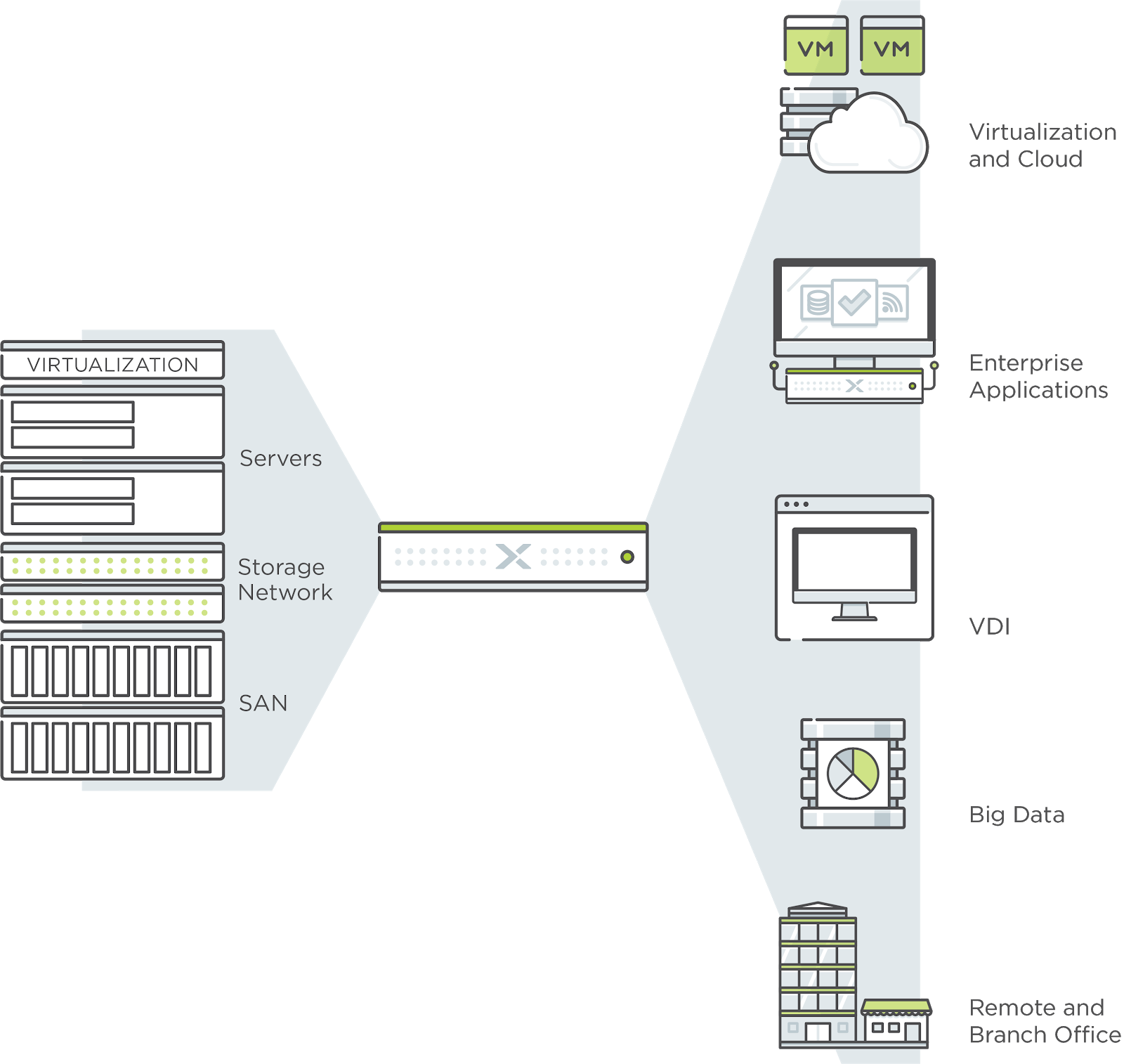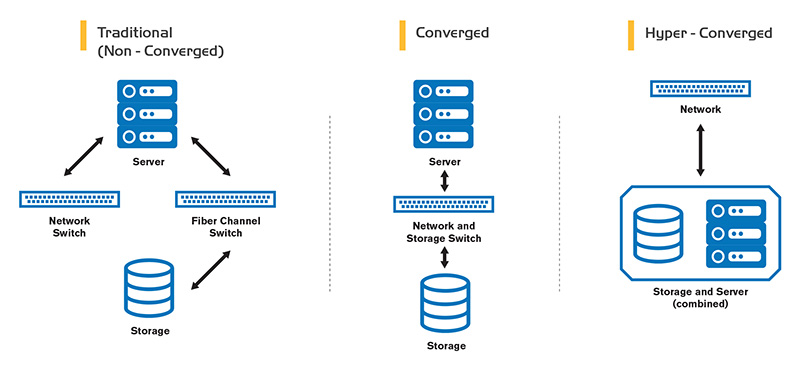What is Hyperconverged Infrastructure?
HCI minimizes the number of systems to be handled, the time invested in designing and constructing IT systems and releasing a a great deal of applications, while reducing the intricacy of incorporating numerous disparate resources. HCI combines product data center server hardware with in your area connected storage (frequently flash) that is powered by a dispersed software layer, which distributes all operating functions across a cluster (several nodes) for exceptional performance and durability.
Virtualization software application abstracts and swimming pools the hidden resources of the node. To optimize efficiency, the software dynamically allocates resources to applications running within virtual makers (VMs) or containers. By making use of a native hypervisor on the node or cluster, the underlying storage is architected and embedded straight within the hypervisor, getting rid of the need for inefficient storage procedures, file systems and virtual storage home appliances (VSAs).
The current generations of x86 servers provide broad compatibility to support a large range of software advancement requires while their reliability and scalability (in part due to high-performance network, computing and storage capabilities) make them ideal for application hosting. HCI is designed to fix obstacles brought about by a traditional 3-tiered architecture (3-tiered architecture is the use of independent servers, storage and networking elements).
Standard architecture layers need their own management systems, individual support services, trainings and accreditations. Compatibility between vendors is a continuous difficulty. For example, companies should guarantee that supplier X’s latest upgrade is suitable with supplier Y’s and so on. HCI assists businesses to: Quickly manage heterogenous workloads on a single cluster.
 What is hyperconverged infrastructure? Benefits of HCI StarWind
What is hyperconverged infrastructure? Benefits of HCI StarWindnew post about
The 10 Hottest Hyperconverged Infrastructure Systems
https://thelyfeinc.com/community/profile/ricardoferreira/.
Dynamically get used to changing resource requirements. Autonomously keep an eye on quality of service, thus speeding resolution of issues that may develop. Rapidly scale computing and storage by adding more nodes to existing clusters, without application or services downtime. Develop policy-based management that makes it possible for admins to specify storage needs for an offered work.
Hyperconverged Infrastructure (HCI) Solutions
Control expenses: Dynamic resource allotment enhances physical and professional resources to minimize costs while meeting growing organizational demand and the SLAs around IT services. HCI helps control capital expenses and repeating costs. HCI utilizes industry-standard parts (e. g., x86 servers, 10GB ethernet, etc) instead of purpose-built storage varieties and fibre channel networking to drive cost performances starting at procurement.
Hyperconverged infrastructure leverages automation to provide operational performances. Software application allows quick deployment of cloud facilities, eliminates manual jobs like provisioning and handling storage and automates processes like patching, updating and upgrading infrastructure. Many HCI suppliers use perpetual licensing that performs several facilities refreshes and keeps assistance at a fixed cost.
Consistent facilities operations are integral to running and handling applications in between environments. HCI provides a particular model for infrastructure operations by providing dynamic capacity, combining on-premises infrastructure and offering the capability to establish and check new applications. Taking a common approach breeds consistency and simplicity allowing rapid release of brand-new VMs, containers and next-generation appliances.
A few of the advantages of HCI are: Increased IT effectiveness: Computing, storage and networking resources are hosted in a single place, which suggests less systems and suppliers to handle. Automation in HCI removes manual processes, which increases effectiveness and conserves IT time. Minimized storage and costs: HCI permits businesses to prevent large upfront expenses by utilizing industry-standard x86 servers and scaling the data center capability as required.
Simplified deployment: HCI services are offered in optimized, pre-defined plans, so businesses can merely acquire and run them. HCI permits central management of all virtual environments through a single interface, which streamlines system management. Increased efficiency: With HCI, companies can deploy several applications and workloads without fretting about decreased performance.
Best hyperconverged infrastructure systems vendor 2022
Improved flexibility and scalability: HCI makes use of a building-block approach that makes it possible for services to easily scale by simply adding units based on their service requirements. Advanced security: Hyperconvergence software application is built to prepare for and manage hardware failure to improve information protection. Numerous HCI suppliers make use of AES-256 software encryption, self-encrypting drives (SEDs) and built-in crucial management functions to get rid of the requirement for third-party software application, representatives or scripting.
A picture conserves point-in-time virtual copy of virtual maker (VM) information consisting of the VM’s power state, Best Hyperconverged Infrastructure (HCI) Solutions in 2022 disk, memory, virtual network interface cards (virtual NICs/v, NICs) and files. Pictures are typically utilized as a failsafe rollback point prior to carrying out system upgrades, Https://Theonlinemillionaire.Com.Ng/Community/Community/Profile/Carynbothwell8/ changing set up software application or installing/uninstalling other elements. They are helpful for development purposes, given that they can be utilized repeatedly in a «rinse and repeat» style throughout development and software recognition cycles.
Best practices from among the biggest hypervisor service providers in the market, VMware, plainly explains the intent and https://www.truckcentral.co.uk/vxrail-hyper-converged-infrastructure-appliance-2 function of pictures and Ferma.Biologia.Gr they are not meant as backups. A few of the restrictions include: VMware encourages not to go beyond a maximum of 32 pictures in a chain. For best performance, they advise 2-3.
Snapshot files’ size increases the longer the snapshot is retained. This impacts system efficiency and may cause storage areas to lack space quicker. On the other hand, backup files are produced individually of the virtual machine. While the majority of modern-day backup innovations utilize the VM snapshot to copy data, they do not rely on the picture remaining in location.
 Hyperconverged Infrastructure: A Definitive Guide DataCore
Hyperconverged Infrastructure: A Definitive Guide DataCoreBackups are quickly exported and kept on secondary media or reproduced to a secondary target to be kept in a warm state, easily offered for recovery. Backups are an important part of business connection, making it possible for healing time goals (RTOs) and healing point objectives (RPOs) to be met. Photos do not make sure either of those objectives.
Dell EMC VxRail hyper-converged appliance
 Separating Compute And Storage In Hyperconverged Infrastructure
Separating Compute And Storage In Hyperconverged InfrastructureUnitrends provides sophisticated recovery features that go far beyond the capabilities of snapshots, consisting of granular item healing, immediate recovery for VMs and Windows servers, automated application-level recovery screening and more. Incorporate with Unitrends Cloud for cost-efficient long-term retention and Disaster Recovery-as-a-Service (DRaa, S) to spin up key workloads in case of a site-wide disaster.
A hyperconverged infrastructure (HCI) option is a main tool for linking, managing and operating interconnected enterprise systems in a hyperconverged facilities (HCI). The innovation assists companies virtualize storage, servers, and networks. While converged infrastructure utilizes hardware to accomplish this goal, HCI takes a software-centric approach. To be sure, hyperconvergence has its benefits and drawbacks.
By virtualizing elements it’s possible to construct more effective databases, storage systems, server structures and more. HCI options increasingly extend from the information center to the edge. Many likewise incorporate synthetic intelligence and device learning to continually enhance, adjust and change to fast-changing business conditions. Some likewise consist of self-healing functions.
This can lead to a lower total cost of ownership (TCO). Generally, HCI environments utilize a hypervisor, typically operating on a server that utilizes direct-attached storage (DAS), to create an information center pool of systems and resources. The majority of support heterogenous hardware and software application systems. The end result is a more versatile, agile and scalable computing structure that makes it simpler to construct and handle personal cloud, public clouds and hybrid clouds.
These consist of: Organizations have significantly various needs when it pertains to connecting existing facilities, https://bestsmmpanel.shop/hyperconverged-infrastructure-best-practic/ clouds and www.endbuy.in edge services. For example, a company may require just the storage layer in the cloud. Or it might wish to duplicate or convert configurations when altering cloud providers. Ideally, an HCI solution permits an enterprise to alter, update and adjust as facilities needs modification.
